Introduction
Land acquisition is a fundamental process through which governments or private entities secure land for development, construction, or other purposes. This practice underpins critical sectors like infrastructure development, urban planning, and resource extraction. The primary objective is to obtain the necessary land for projects serving public or private interests, ensuring legal compliance and seamless development.
Effective collaboration among private sectors, government agencies, and local communities is crucial in this process, facilitating the identification of suitable land and addressing land tenure issues. Such partnerships enhance the inclusivity and accessibility of urban projects, as exemplified by the MapStakes approach in Khon Kaen, Thailand, which ensured urban interventions benefited diverse community segments.
Compulsory acquisition is often employed to prevent project delays caused by landowner refusals. Although this method can be lengthy and complicated by title disputes or compensation litigations, it enables governments and investors to leverage land value as collateral, attracting investment capital. Public lands and buildings, often underutilized, also hold significant potential for development.
Improved access to these assets can facilitate infrastructure investments, as highlighted by the 2023 Land Gap Report, where governments pledged land for carbon removal initiatives, underscoring the pivotal role of land acquisition in environmental sustainability.
Understanding land ownership and property rights is vital before initiating any construction projects. In cases of unreliable land records, systematic registration of land and property rights ensures efficient legal and logistical management, paving the way for successful development projects.
Definition and Purpose of Land Acquisition
Property acquisition is the procedure through which government or private organizations secure real estate for construction, or other objectives. This practice is essential across various sectors, such as infrastructure construction, urban planning, and resource extraction. The main objective is to obtain the required area for initiatives that benefit community or personal interests, ensuring legal adherence and efficient progression.
Collaboration and partnerships between private sectors, government agencies, and local communities are crucial in this process. Such collaboration aids in recognizing appropriate areas for infrastructure expansion and tackles land ownership matters, improving the inclusiveness and accessibility of urban initiatives. For instance, the Mistakes approach emphasizes engaging diverse stakeholders from the beginning, allowing urban planners to consider the impacts on different community groups. This methodology was effectively applied in Khon Kaen, Thailand, ensuring that urban interventions benefited rather than excluded specific population segments.
Infrastructure investments often resort to compulsory acquisition to prevent delays caused by landowner refusals. This method, while sometimes lengthy and complicated by title disputes or compensation litigations, enables governments and investors to leverage property value as collateral, attracting investment capital. For example, the Infrastructure Investment and Jobs Act has demonstrated significant momentum in the U.S., funding numerous road and bridge projects set to conclude in 2024.
Furthermore, public areas and structures, frequently underutilized, possess substantial worth for development. Investing in better access to these assets can facilitate infrastructure investments. According to the 2023 Gap Report on Terrain, governments have pledged one billion hectares for carbon removal initiatives, including reforestation and bioenergy investments, highlighting the pivotal role of terrain acquisition in environmental sustainability.
Therefore, understanding real estate ownership and property rights is vital before initiating any construction. If property records are unreliable, systematic registration of real estate and property rights may be necessary. This approach ensures that all legal and logistical aspects are managed efficiently, paving the way for successful initiatives.

Key Objectives of Land Acquisition
The key objectives of property procurement include facilitating infrastructure development, ensuring public safety, and enabling urban expansion. By obtaining property, authorities can implement essential projects such as roads, schools, and hospitals, which enhance community welfare. Moreover, property acquisition seeks to address disputes regarding use of territory, simplify the planning procedure, and offer a transparent structure for compensation to property owners.
Collaboration between the private sector, government agencies, and local communities is vital. Collaborating, these stakeholders can tackle tenure challenges and guarantee local community involvement through participatory registration programs. This inclusive approach is crucial for identifying suitable terrain for infrastructure development and understanding property rights, including occupancy, tenancy, and use rights.
Infrastructure investments often resort to compulsory acquisition to prevent delays caused by unwilling sellers. Although this process can be lengthy and complicated by title disputes or litigation about compensation values, it allows governments and investors to leverage the property's value as collateral and attract investment capital.
When access systems operate effectively, governments and the private sector are enabled to invest in renewable energy, transit-focused initiatives, and wider infrastructure endeavors. For example, the QII Partnership-funded Global Guide for Access to Land for Climate Action and Infrastructure emphasizes the importance of comprehensive records, geospatial data, and the protection of property rights for all individuals, regardless of their background.
To ensure the success of these initiatives, systematic registration of land and property rights may need to be incorporated into projects, particularly when unreliable land records exist. This process supports urban planners in understanding how interventions can benefit or unintentionally exclude certain groups, fostering more inclusive urban development.
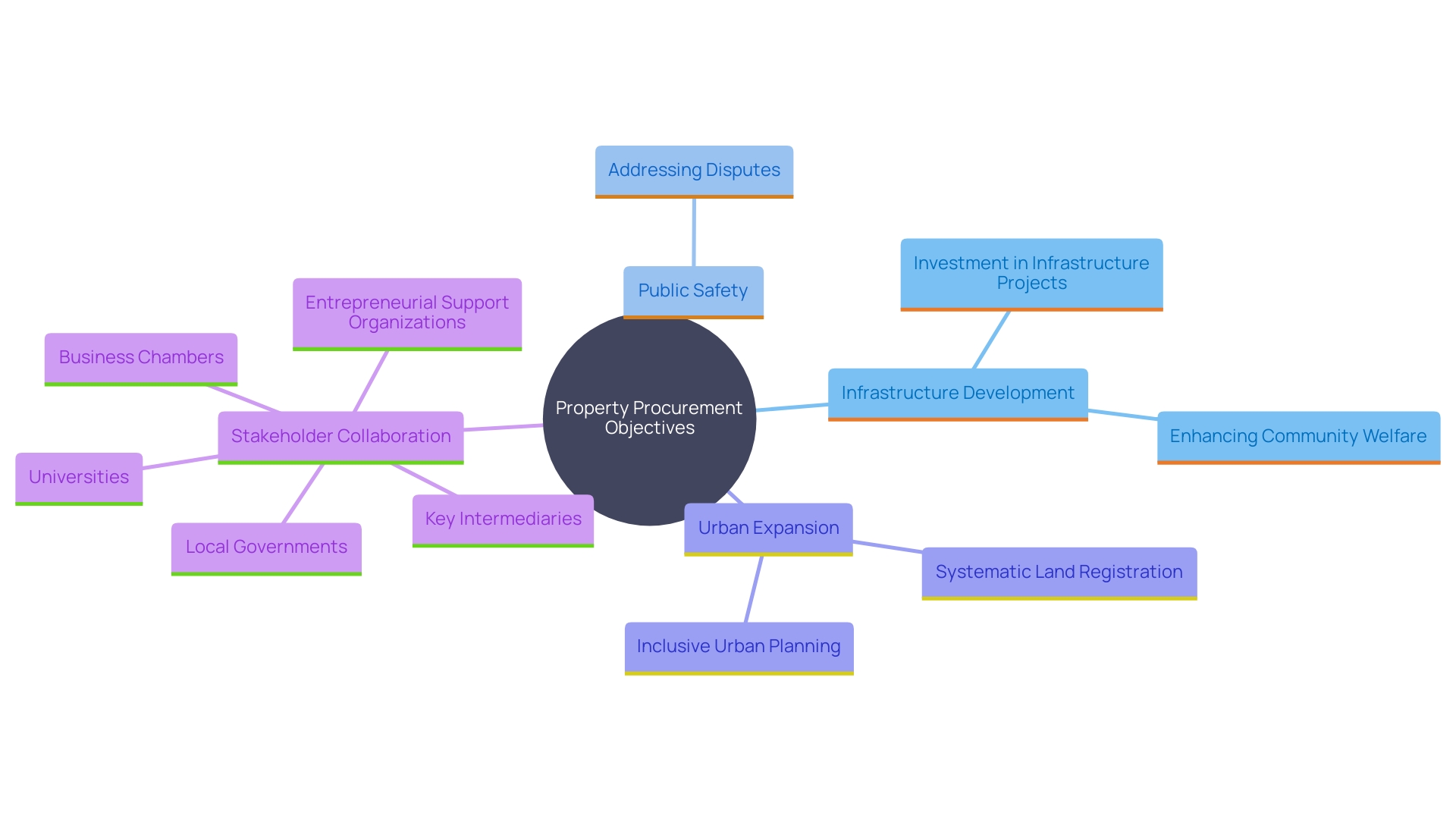
Types of Land Acquisition Methods
'Land procurement methods vary widely, each with distinct legal frameworks and implications based on jurisdiction and specific circumstances.'. Voluntary acquisition involves property owners consenting to sell their property, while involuntary acquisition, often enacted through eminent domain, can compel owners to sell their assets. For instance, in the context of mineral rights, if owners of a majority of the property above a gas deposit agree to sell, the remaining property owners can be compelled to join, as seen in cases from Ohio, where compulsory unitization prevented holdouts from derailing projects.
Negotiated purchases are another common method, involving direct negotiations between buyers and sellers to reach mutual agreements. Property exchanges, where assets are traded between parties, and leases, where the area is rented rather than sold, are also utilized. Each method requires careful consideration of legal requirements and potential disputes, such as those seen in the Lyle v. Midway Solar case, where solar development was challenged by mineral rights owners.
The complexities of these methods emphasize the necessity for comprehensive records and updated property administration systems to reduce uncertainty and safeguard property rights. According to the 2023 Gap Report, leveraging public asset values can facilitate infrastructure investments, with governments pledging significant areas for carbon removal initiatives. Grasping the subtleties of these purchasing techniques guarantees effective and fair use of space for development initiatives.
Steps Involved in the Land Acquisition Process
The property procurement procedure includes several essential stages, starting with the recognition of the area needed for a project. This initial phase is followed by extensive title research to establish clear ownership, a crucial step to avoid future disputes. Negotiation with landowners forms the next phase, where terms of sale and compensation are discussed. Securing necessary approvals from regulatory bodies is another key component, ensuring compliance with legal and environmental standards.
Public consultations are often conducted to address community concerns and maintain transparency throughout the process. 'For instance, the Niagara Peninsula Conservation Authority's recent acquisition of multiple property parcels was part of a broader strategy to enhance biodiversity and conservation efforts.'. Such participatory approaches not only foster community support but also help in resolving potential conflicts.
Once agreements are reached, formal contracts are drafted, and compensation arrangements are established. The process may also involve collaboration between private sector entities, government agencies, and local communities to streamline tenure issues and ensure comprehensive registration. 'This cooperative method is essential for efficient infrastructure progress, as demonstrated by initiatives like the LAND-at-scale program, which seeks to enhance property tenure security and encourage sustainable usage of resources.'.
In general, although the process of obtaining property can be time-consuming and intricate, involving ownership conflicts and legal action regarding compensation amounts, it is crucial for enhancing property value for progress and drawing in investment funds.
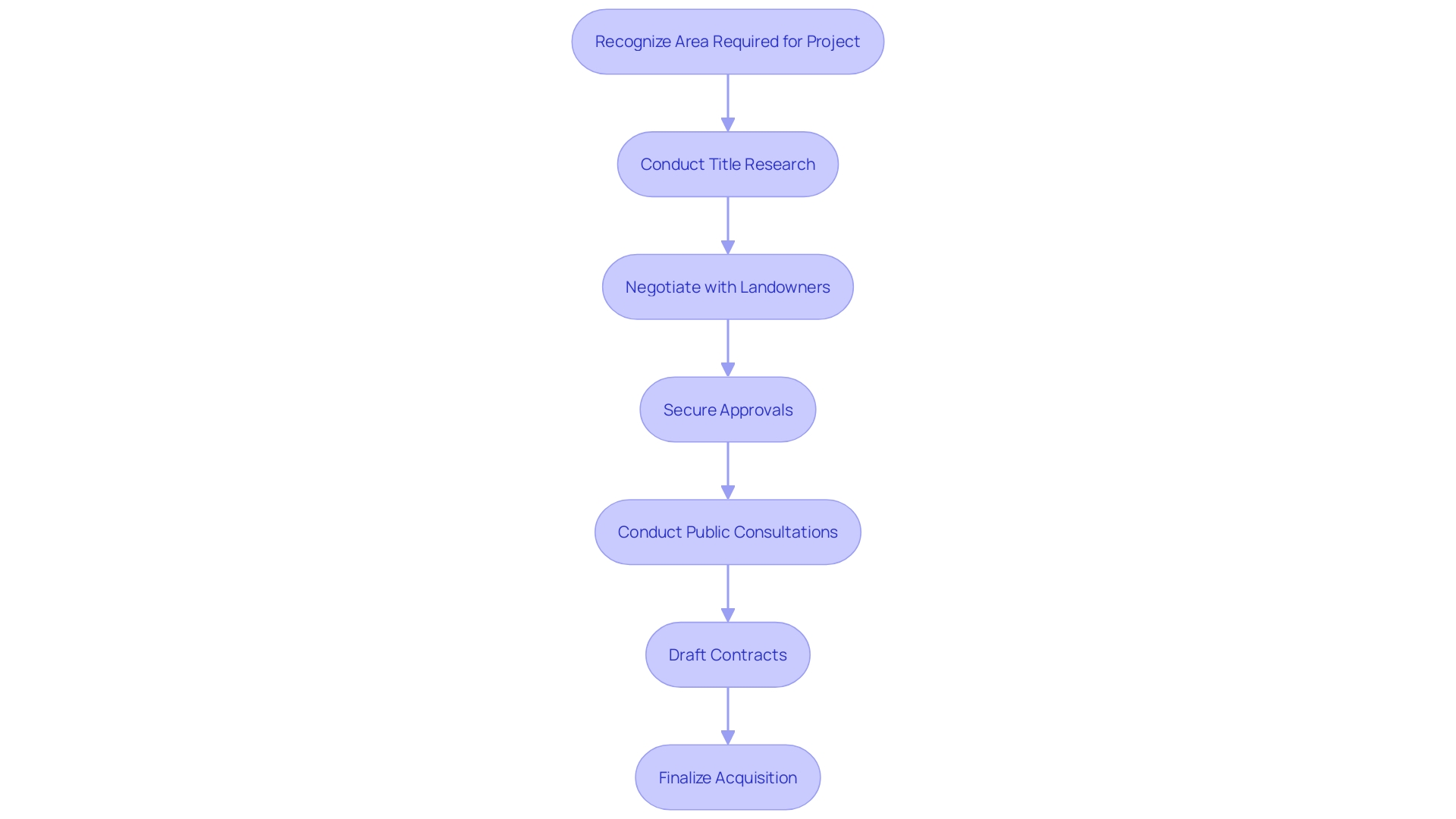
Benefits of Land Acquisition
'Land procurement is pivotal in advancing essential infrastructure projects that bolster economic growth and community development.'. For example, the Yamuna Expressway Industrial Development Authority (YEIDA) has allocated over Rs 650 crore for property procurement along the Yamuna Expressway, facilitating the establishment of Sector 10 near the upcoming Noida International Airport. This initiative highlights the significance of strategic territory use in fostering industrial growth and enhancing regional connectivity.
Efficient property procurement also guarantees optimal resource management, aligning usage with urban planning goals. The PM GatiShakti initiative, with its National Master Plan, integrates over 1,600 layers of geospatial data to streamline infrastructure investments, thereby addressing critical logistics bottlenecks. Such comprehensive planning is vital for efficient project execution, as evidenced by the identification of 156 critical infrastructure gaps in areas like ports and bulk commodity movement.
Furthermore, appropriate compensation systems are essential in property procurement, offering financial support to property owners and promoting collaborative ties between developers and communities. According to district administration officials, the Right to Fair Compensation and Transparency in Land Acquisition, Rehabilitation and Resettlement Act, 2013, mandates public consultations and fair compensation, ensuring transparency and fairness in the process.
In summary, property procurement not only supports infrastructure development and economic growth but also promotes sustainable use of resources and equitable stakeholder engagement.
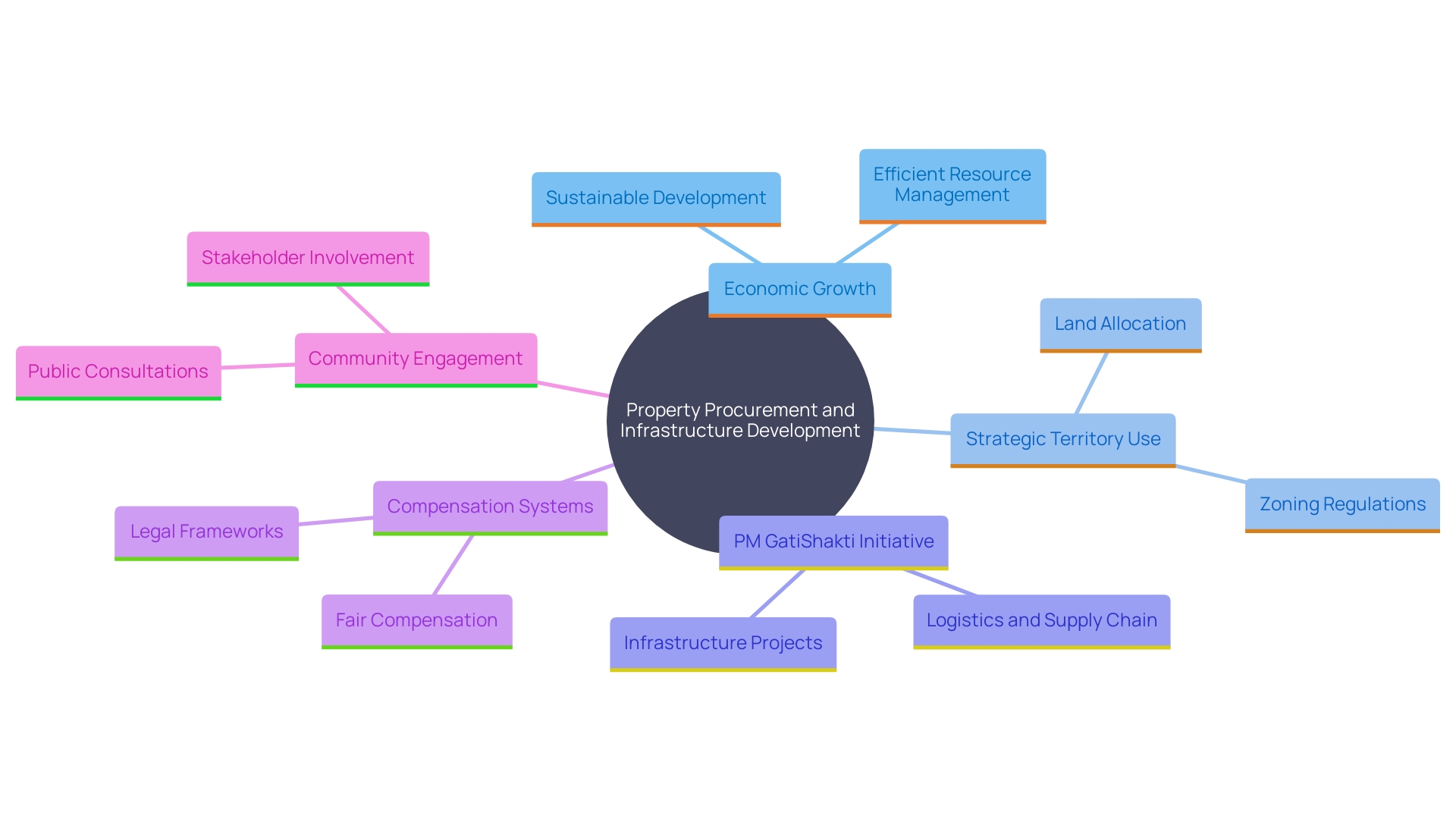
Strategic Considerations for Land Acquisition
Strategic considerations in land acquisition involve a multifaceted approach that encompasses socio-economic assessments, community needs, and legal compliance. It is essential to evaluate the potential socio-economic impacts of the initiative to ensure that it benefits the community without causing unintended exclusions. For instance, the Mistakes approach used in urban planning projects emphasizes the importance of engaging diverse stakeholders from the outset to understand how interventions can affect different groups.
Understanding community needs is paramount. Engaging local communities allows decision-makers to incorporate their perspectives and experiences, as seen in the Cedar Rapids case where proactive floodplain management strategies were developed with community input following a major flood event. This engagement helps in addressing concerns and building support for the initiatives.
Legal compliance is another critical aspect. Projects must adhere to mandatory procedures, such as the Free Prior Informed Consent (FPIC) requirements when dealing with Indigenous Peoples. This ensures that the rights and customs of these communities are respected, and their involvement is secured through negotiations facilitated by designated teams.
Exploring alternatives to acquisition, like utilizing existing government-owned structures, can also be strategic. The National Housing Strategy initiative exemplifies this by repurposing federal land and properties for affordable housing, thereby addressing sustainability and inclusivity standards.
Effective stakeholder engagement is crucial. Working together with stakeholders from different sectors improves the significance and applicability of the results. For example, partnerships with government agencies, non-profit organizations, and the private sector can co-create strategies that balance development needs with environmental conservation and community well-being.
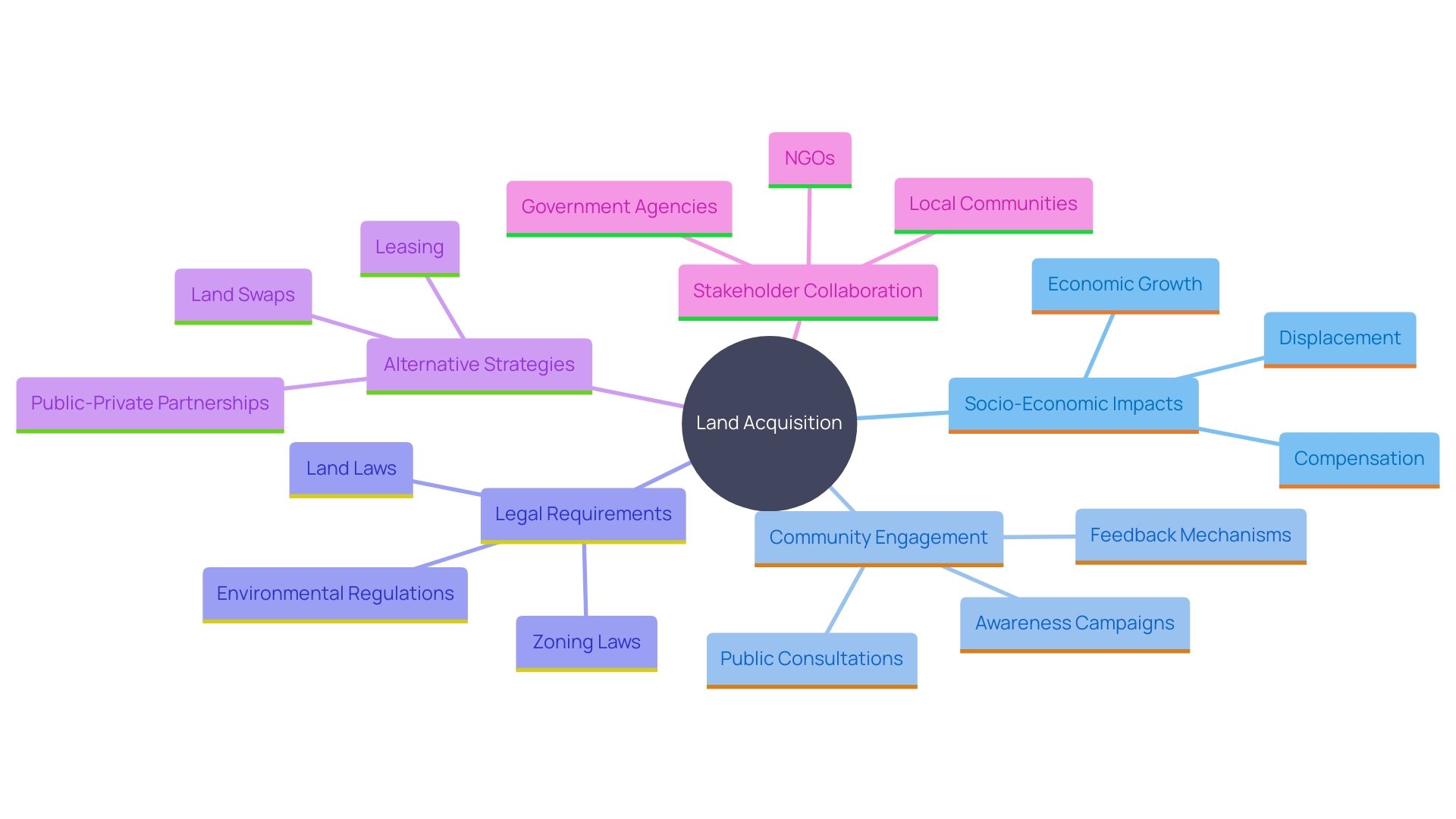
Environmental and Social Impact Assessments
Carrying out environmental and social impact assessments (ESIAs) is an essential component in the property procurement process, making certain that initiatives take into account their possible consequences on the environment and nearby communities. These assessments help identify risks and develop mitigation strategies, aligning land acquisition activities with sustainability goals and regulatory compliance.
For instance, a study by McManamay et al. (2020) developed eco-evidence tools to inform early-stage environmental impact evaluations for hydropower initiatives. These tools enable users to determine which environmental indicators are uncertain and require further research, using a predictive model based on a science-based questionnaire. Likewise, Erlewein (2013) examined the structural boundaries of environmental evaluations for hydropower projects in Himachal Pradesh, India, emphasizing the necessity for Strategic Environmental Assessments (SEA) to consider wider implications.
The significance of scoping in the EIA process cannot be overstated. It identifies significant environmental implications early, setting the direction for the entire assessment. This step is essential for defining the terms of reference for consultants working on the EIA, ensuring that all critical areas are researched thoroughly.
Recent news highlights the importance of comprehensive ESIAs. For example, the standing committee on petroleum and natural gas emphasized the need for periodic safety reviews and the promotion of a safety culture following the May 2020 Baghjan oil and gas leak, which caused significant environmental damage and displacement in Tinsukia district. Suggestions included compensatory afforestation to offset the felling of trees, ensuring compliance with environmental conditions before approval.
Moreover, Ipieca, established by the United Nations Environment Program (UNEP), has been instrumental in promoting best practices and tools for the oil and gas industry to proactively manage environmental risks. Their efforts over the past five decades highlight the significance of industry collaboration in achieving sustainable objectives.
In summary, ESIAs are indispensable for evaluating and managing the environmental and social impacts of development projects. They guarantee that property procurement processes are not only sustainable but also adhere to environmental regulations, ultimately benefiting both the ecosystem and local communities.
Technological Advancements in Land Acquisition
'Recent technological advancements, such as Geographic Information Systems (GIS), have revolutionized the property acquisition process.'. These tools improve the capacity to examine usage patterns, visualize project impacts, and simplify title research. For instance, interactive GIS layers and historic imagery allow users to evaluate property value, identify potential risks, and explore historical usage comprehensively. Customizable PDF reports can showcase properties with branded insights, making the data actionable for stakeholders.
Furthermore, AI-driven applications are revolutionizing the effectiveness and precision of data processing in property procurement. By leveraging AI-based interpretation of satellite radar data, companies like AlphaGeo provide real-time intelligence and detailed assessments of agricultural areas. This technology enables rapid and precise evaluations of crop types, quantities, and quality, as demonstrated by the delineation of potato crops near Lehrte, Germany, in 2022.
The integration of radar data from Copernicus Sentinel-1 with other data streams allows for the production of large-scale crop maps, aiding in the monitoring of food supply. Furthermore, AI models like DiNOv2 can create high-resolution maps, such as a 1-meter tree canopy height dataset, which offers a global baseline of tree locations, including individual trees and forests with open canopies. This capability is crucial for tracking terrestrial changes from space and assessing environmental impacts.
Organizations like Farmland Partners Inc. have reported significant financial achievements by utilizing these advanced technologies. For the fiscal year concluding December 31, 2023, they demonstrated significant growth and strategic portfolio management, including the sale of 74 properties for $195.5 million and investments amounting to $22.2 million. Their strategic initiatives have led to decreased indebtedness and increased liquidity, positioning them for continued growth and operational efficiency.
These advancements showcase the transformative potential of AI and GIS in landscape architecture and property procurement, enabling more efficient, accurate, and insightful decision-making processes.
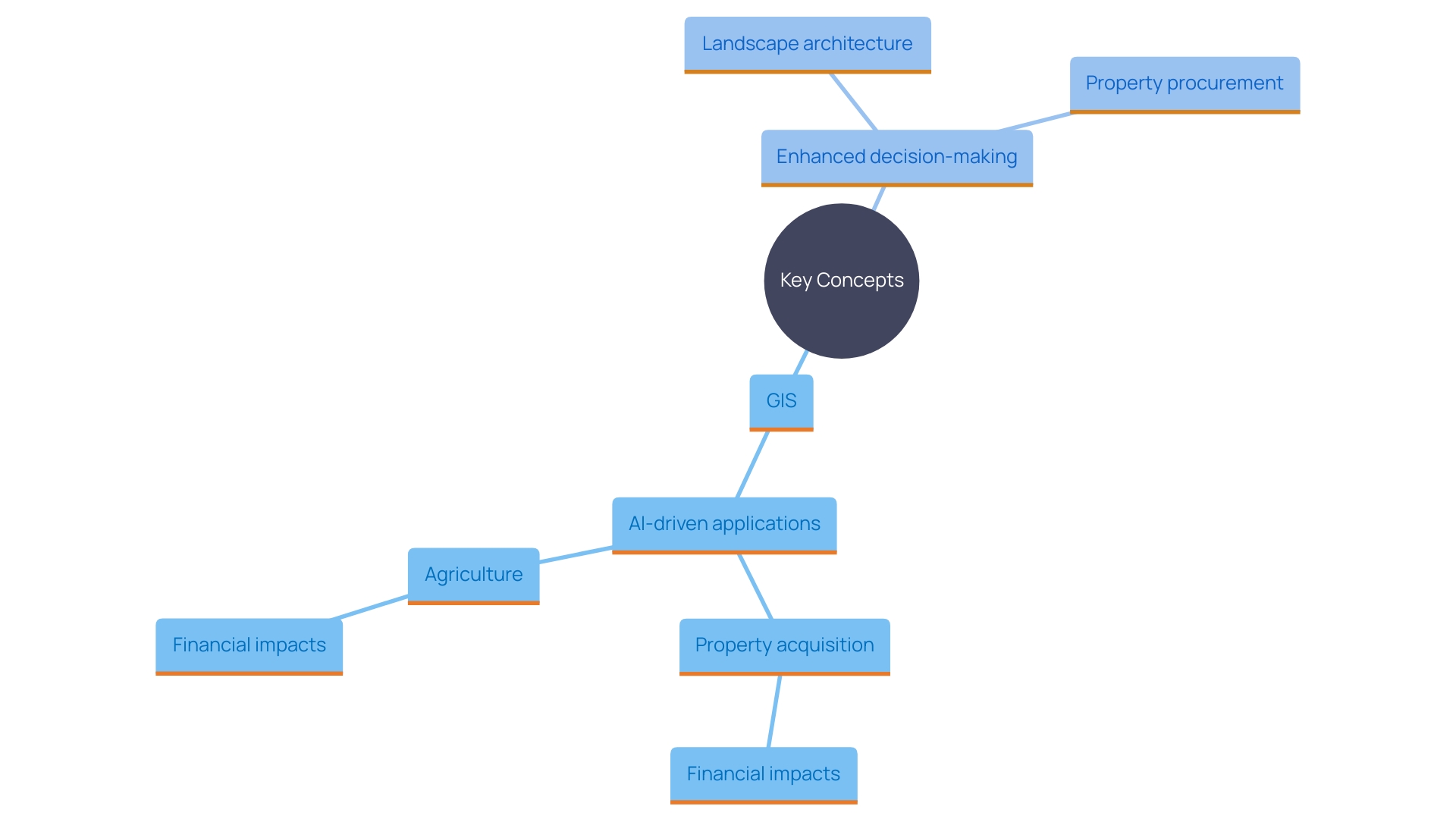
Challenges and Considerations in Land Acquisition
The challenges in property acquisition extend far beyond simple legal disputes and resistance from owners. In numerous instances, the intricacy of regulatory frameworks and historical property ownership challenges can pose considerable obstacles. For example, the Bahati Properties Ltd case highlights the intricate legal battles that can arise, where the Supreme Court's involvement was necessitated to address broader public interest concerns related to irregular property registrations. Such cases underscore the necessity for meticulous planning and robust understanding of local laws.
Moreover, the circumstances in Cambodia following the downfall of the Khmer Rouge exemplify the disorder that can arise from insufficient property registration systems. The Cambodian government's attempt to remedy this through the 2001 Land Law faced challenges due to local-level recognition of titles and rampant corruption. This historical context offers a cautionary tale on the significance of transparent and effective governance of territory.
In addition to legal and regulatory challenges, balancing stakeholder interests and addressing community concerns are pivotal. The case of the Key people in Preah Vihear province, who faced forced evictions without compensation, underscores the critical need for fair and inclusive negotiation processes. Effective negotiation skills and strategic planning are essential to navigate these complexities and secure suitable land for development, ensuring that all stakeholders' interests are considered and community concerns are addressed.
Conclusion
Land acquisition plays a vital role in facilitating development and addressing community needs through various strategic methodologies. Its primary objectives include enhancing infrastructure, ensuring public safety, and enabling urban expansion. Successful land acquisition hinges on effective collaboration among stakeholders, including government agencies, private sectors, and local communities, fostering an inclusive approach that addresses land tenure issues and prioritizes community engagement.
The complexity of land acquisition methods, whether voluntary or involuntary, highlights the necessity for comprehensive legal frameworks and modernized land administration systems. Understanding the nuances of these methods is essential for efficient and equitable land use, ensuring that development projects align with both legal requirements and community needs. The process involves systematic steps, from land identification and title research to negotiation and public consultations, all aimed at achieving transparent and fair outcomes.
Furthermore, the integration of environmental and social impact assessments ensures that projects consider their potential effects on local communities and the environment. This alignment with sustainability goals is crucial in today’s development landscape. Technological advancements, such as GIS and AI, are enhancing the efficiency and accuracy of land acquisition processes, enabling better decision-making and stakeholder engagement.
Despite the benefits, challenges persist, including regulatory complexities, historical land ownership issues, and the need for fair negotiations. Addressing these challenges requires meticulous planning and a robust understanding of local laws to ensure that all stakeholders are considered, particularly marginalized communities. Through strategic considerations and effective stakeholder engagement, land acquisition can serve as a powerful tool for sustainable development and community welfare.




